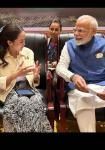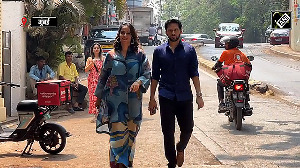Politicians may not understand things in great detail, but they surely understand that creating fear in the minds of people to garner votes, works. Rahul Gandhi is the latest politician who has tried to use this strategy, just that in his case, it did not work, says Shonalee Biswas.
The late Benazir Bhutto during her heydays as the prime minister of Pakistan was referred to as the "perennially pregnant prime minister" or PPP, which was also the short form for her political party, the Pakistan People's Party.
Taking on from Benazir's PPP, and dropping one P, we can christen Rahul Gandhi, PP, or the perennial prince. And the prince is up to his tricks again. This time trying to create fear in the minds of denizens of Mayaland (read Uttar Pradesh).
The Congress general secretary riding pillion managed to enter the Bhatta-Parsaul villages on May 11, giving the district administration a slip. The villagers here have been protesting against the government's decision to acquire their land.
From the media reports that came out, it seems the rajkumar patiently heard out people and a few days later took their problems to the Prime Minister Manmohan Singh. "People have been raped, farmers have been killed," said Gandhi. "There is a set of 74 (mounds of) ashes there with dead bodies inside. Everybody in the village knows it...Women have been raped, people have been thrashed. Houses have been destroyed," claimed Gandhi.
Now these were rather serious allegations that were being made. But investigations carried out revealed that the situation was nowhere as fearful as the young Gandhi was making out to be. Of course, the entire Congress machinery is now out there trying to defend their yuvaraj with some ridiculous explanations like "he is not saying that he has evidence".
What is interesting is though is the fact that Rahulji (as everybody in the Congress Party likes to call him) was trying to use the tried and tested strategy of creating fear in the minds of people, in the hope of the projected 'fear' translating into votes for the Congress in the next assembly election in Uttar Pradesh.
Of course, Gandhi did not get his research right or he would have become the latest politician to get this killer app of creating 'fear' in the minds of people in the hope of getting votes, right. "UP is not safe under the rule of Mayawati. So vote for me. Vote for the Congress," would have been his rallying cry.
But before we start blaming him too much he was only doing what others have already done before him.
Now take the case of his cousin Varun (who recently got married) made front page headlines when during the last elections to the Lok Sabha in a speech he said "Ye panja nahi hai, ye kamal ka haath hai. Ye kat** ke galey ko kaat dega chunaav ke baad."
We all know what he was referring to. Of course Varun defended himself by saying "Yes, but I would like to say that I stand for the truth, what I have said I have said but I have not said I have not said." Try to figure out what that means.
Before, you start thinking that only the BJP wallahs follow the strategy of fear, hold on. "When a big tree falls, the ground shakes," said Rajiv Gandhi, Rahul's father, after Rahul's grandmother and Rajiv's mother, Indira Gandhi, was assassinated.
As his well known by now a section of the Indian National Congress (back then known as the Congress-I) whipped up mass frenzy against the Sikhs after the assassination of Indira Gandhi. In the pogrom that followed Sikhs were killed all across northern and eastern India. And the Congress Party got 415 seats out of the 540 seats in the Lok Sabha, a feat not achieved even by Jawaharlal Nehru, the biggest leader that the party has ever had.
The party Rahul baba has targeted i.e. the Bahujan Samaj party, is built around the concept of creating fear in the minds of the voter.
Mayawati's mentor Kanshi Ram, had formed the the Dalit Soshit Samaj Sangharsh Samiti or DS4, before forming the BSP. The rallying cry was "Thakur, Brahmin, Bania Chhod, Baki Sab Hain DS4."
This worked so well that when Ram decided to form the BSP he came up with a similar sounding but a more subtle slogan. "Tilak Tarazu aur Talwaar, inko maaro joote chaar."
Lalu Prasad Yadav, ruled the "undivided" and divided Bihar for 15 odd years directly and indirectly through Rabri Devi. He had build a deadly combination of through proxy by building a deadly combination of Muslim and Yadav votes (or MY as the media referred to it). Yadav even went on record to say that development does not lead to votes, and he was right for a while.
The biggest opposition party in the country the Bhartiya Janta Party(BJP) owes its entire existence to the strategy of fear. In the 1984, Lok Sabha, the party had two MPs. In the 1989, Lok Sabha this number increased to 88and it further increased its tally to 118 in the 1991 Lok Sabha. In 1991, the party would have won even more seats, had Rajiv Gandhi not been assassinated during the course of campaigning for the election. This helped the Congress Party ride on a sympathy wave and get more seats that it would have.
The Ramjanambhoomi-Babri Masjid issue helped catapult BJP from being a small political front of the Rashtriya Swayamsevak Sangh to being a party which had substantial following across parts of Northern, Western and Eastern India.
Vishwanath Pratap Singh, with whom the BJP allied with in the 1989 elections, built his entire career after being thrown out of the Congress Party by first seeking to implement the recommendations of the Mandal commission and then implementing them. The upper casts started to further hate the lower castes. And the lower castes loved VP and voted for him and his party.
The Shiv Sena led by Bal Thackeray has been one of the best exponents of this strategy. It first put fear of Tamils in the minds of the Marathi Manoos then Muslims as times changed and now the bhaiyas or people from UP and Bihar.
Or take the case of Raj Thackeray, who split from his uncle Bal Thackeray, and started on a rather promising note, talking about development for all. But very soon he realised that this wouldn't lead to instant political gains and started creating fear in the minds of the Marathi Manoos against people from North India. The Shiv Sena which has mellowed down over the years had to go back to its strategy of fear to tackle the junior Sena.
Then there are also examples of parties like DMK, which have been built on creating the fear of the loss of culture and language.
So the question is what is it that makes the strategy of creating fear in the minds of people, such a killer app? Fear "is what our brains remember..."writes Martin Lindstrom in his latest book Buyology. Fear creates what Lindstrom calls "somatic markers" or brain shortcuts that link the brand sold to what needs to be done to take care of the fear: "Don't want Indians to take away your jobs? Vote for Obama." It is not as simple as that, but that is what it essentially means.
It also gives rise to anxieties and insecurities of people and helps politicians come up with a war cry and make themselves easily heard. As Bill Bonner and Lila Rajiva write in Mobs, Messiahs and Markets "Men are ready to die for the group and kill anyone who resists its will."
At a neurological level, fear activates the region of the brain known as the amygdala, which is the seat of fear, dread and anxiety. Lindstrom points out in his book that "scanning voters' amygdalas could be beneficial in designing" better political ad campaigns.
The politicians may not understand things in such great detail, but they surely understand that creating fear in the minds of people to garner votes, works. Rahul Gandhi is the latest politician who has tried to use this strategy, just that in his case, it did not work.











 © 2025
© 2025